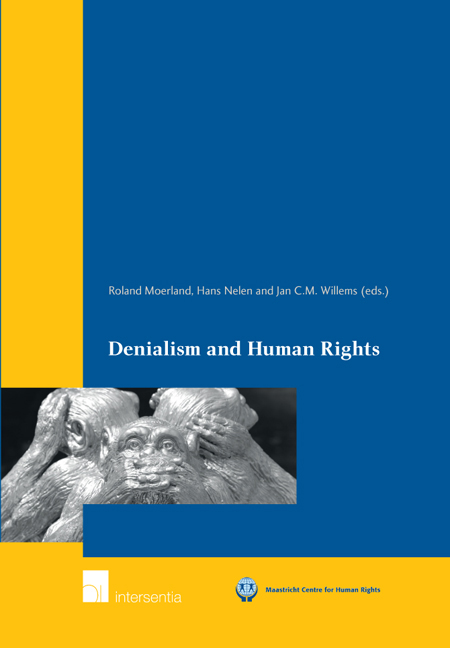Book contents
- Frontmatter
- Contents
- Acknowledgements
- Chapter I Introduction
- Chapter II Denialism and the Problem of Indifference
- Chapter III Denial and Acknowledgment in Public Responses to Information about Human Rights Violations
- PART I CHILDREN'S RIGHTS
- PART II GENOCIDE
- Chapter VIII The BBC Documentary ‘Rwanda's Untold Story’: Acknowledging Genocide or Denying It?
- Chapter IX Fighting NS Ideology and Holocaust Denial in Austria: Past and Present Perspectives
- Chapter X The Holocaust and its Denial: A Paradigm in our Historical Culture
- Chapter XI Can the Law Understand the Harm of Genocide Denial?
- Chapter XII On the Breaking of Consensus: The Perinçek Case, the Armenian Genocide and International Criminal Law
- PART III (INTER)NATIONAL ORGANISATIONS
- PART IV NEW PENOLOGY
- PART V SOCIAL, ECONOMIC AND CULTURAL RIGHTS
- About the Authors
- Maastricht Series in Human Rights
Chapter IX - Fighting NS Ideology and Holocaust Denial in Austria: Past and Present Perspectives
from PART II - GENOCIDE
Published online by Cambridge University Press: 19 September 2018
- Frontmatter
- Contents
- Acknowledgements
- Chapter I Introduction
- Chapter II Denialism and the Problem of Indifference
- Chapter III Denial and Acknowledgment in Public Responses to Information about Human Rights Violations
- PART I CHILDREN'S RIGHTS
- PART II GENOCIDE
- Chapter VIII The BBC Documentary ‘Rwanda's Untold Story’: Acknowledging Genocide or Denying It?
- Chapter IX Fighting NS Ideology and Holocaust Denial in Austria: Past and Present Perspectives
- Chapter X The Holocaust and its Denial: A Paradigm in our Historical Culture
- Chapter XI Can the Law Understand the Harm of Genocide Denial?
- Chapter XII On the Breaking of Consensus: The Perinçek Case, the Armenian Genocide and International Criminal Law
- PART III (INTER)NATIONAL ORGANISATIONS
- PART IV NEW PENOLOGY
- PART V SOCIAL, ECONOMIC AND CULTURAL RIGHTS
- About the Authors
- Maastricht Series in Human Rights
Summary
INTRODUCTION
Denial has become a common concept in our everyday lives as well as in everyday language and appears to be something that we are generally familiar with. Terminally ill patients who fail to acknowledge the severity of their illness, alcoholics who deny that they have a problem and claim that after all they are just social drinkers; politicians who reject responsibility for a disaster, and society turning a blind eye to the catastrophic situation of asylum seekers, may all be situations which can be classified as states of denial. Despite the common nature and familiarity of the concept, a uniform scholarly definition is, however, hard to come by. It seems that we know denial when we see it but beyond that ‘denial is a presence that evaporates, the nearer you get to defining it’.
Despite its elusive character there are serval features of the concept on which there seems to be academic consensus. First, denial is generally seen as a defence or coping mechanism which helps people to protect themselves against painful and threatening internal (emotions) and/or external realities (situations). Ultimately, denial is thus about the need to be free from a troubling recognition.
As a concept the mechanism of denial is in itself neutral. Depending on the circumstances it can, however, carry positive or negative connotations. On the one hand it functions as a coping mechanism which we all use to deal with traumatising events, threatening realities, etc. On the other hand denial can also be used as an intentional tool of collusion, cover ups, propaganda and political manipulation. In other words, the concept of denial ‘serves not only those who suffr. It is indispensable for those who deliberately inflict terrible suffering on their fellow human beings – and for others who come to know about this’.
In any case, the very core of the concept of denial can be found in the paradoxical state of knowing and not knowing at the same time. For the defence mechanism to function, one first needs to be aware of a certain stimulus, a threatening reality, in order to subsequently be able to turn a blind eye to it or to reinterpret the situation as a less threatening one.
- Type
- Chapter
- Information
- Denialism and Human Rights , pp. 175 - 198Publisher: IntersentiaPrint publication year: 2016

